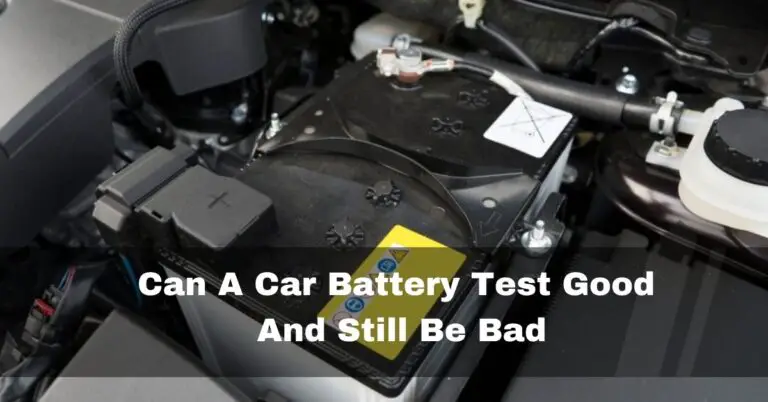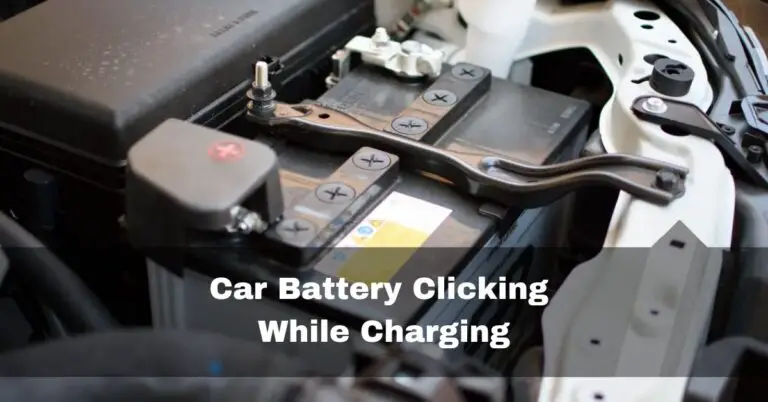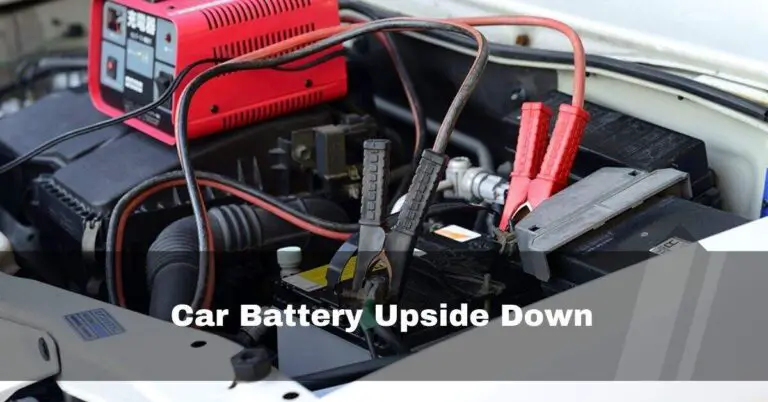Battery Only Reading 10v – [2024] Why? Should I Recharge It
I recently encountered a situation where my car battery was only reading 10 volts, and let me tell you, it was a bit alarming. I knew I had to address this issue promptly because a healthy car battery should always maintain a voltage above 11.9 volts.
Car battery 10 volts?
A fully charged, healthy battery should rest at 12.7V or so. If it was running for long enough to charge and not frozen, 10V sounds like it must have a dead cell, where one cell (of the 6 in a normal battery) has shorted and isn’t producing any voltage.
In this post, we’ll look into some possible reasons why a battery reading of 10V occurs and discuss several suitable fixes. I hope my journey can guide you in troubleshooting and fixing a battery reading of 10 volts in your own vehicle.
Table of Contents
Why Is The Car Battery Only Reading 10v?
I recently faced the perplexing issue of my car battery only reading 10 volts, and it got me digging into the possible reasons behind this concerning situation.
1. Dead Cell In The Battery:
Car battery showing 10 volts? Discovering that my battery was only showing 10 volts raised immediate concerns, especially since a fully charged and healthy automobile battery typically rests at 12.7 volts. After some research and troubleshooting, I learned that a common culprit for this discrepancy is a dead cell within the battery.

Most car batteries consist of six cells, and when one of them dies or shorts out, it can significantly impact the overall voltage. In my case, it seemed that one of the cells had indeed failed, leading to the lower voltage reading. This dead cell was unable to produce the necessary voltage, resulting in a reduction in the battery’s overall capacity.
source:quora
Also Read: Car Battery Clicking While Charging
2. Over-Discharging:
Over-discharging is another possible reason for a battery reading of 10V. Your battery’s capacity may be significantly reduced if you often deplete it to deficient levels without quickly charging it. Repeated deep discharges can weaken a battery over time, making it more challenging to keep an adequate charge.

3. Aging Battery:
Car batteries typically last between three and five years, depending on usage and care. Voltage measurements decrease when a battery ages because its overall capacity declines. As a result, if your battery is older and continuously registers around 10 volts, it may have outlived its usefulness.
4. Storage Without Charging:
A battery can progressively lose its charge if it isn’t periodically charged while idle for an extended time. Self-discharge is a process that happens as a result of chemical reactions taking place inside the battery. Due to the self-discharge process, the battery’s voltage may drop to as little as 10 volts over time.
5. Continuous Load Without Automatic Cut-Off:
Your car’s battery might become discharged over time if a device or electrical component has been connected and continuously draws power without an automatic shut-off system. It frequently occurs when aftermarket items, such as car stereos, GPS units, or alarms, are fitted improperly or without taking proper wiring concerns into account.

Also Read: The Car Battery Has Voltage But No Amps
6. Loose Or Corroded Battery Connections:
Poor electrical connections occasionally result in a low voltage reading. Lower voltage readings can be caused by loose or corroded battery connections that block the flow of electricity. Corrosion buildup on the terminals, which might result in resistance, can reduce the battery’s ability to deliver power effectively.

How I Fix Car Battery Only Reading 10v? Sharing personal experience:
It was a situation that required some troubleshooting and a hands-on approach to resolve. Here’s how I tackled the issue based on my personal experience:
1. Replace Battery:
Unfortunately, resolving a dead cell issue isn’t a DIY fix. In my situation, I sought the assistance of a professional mechanic to conduct a comprehensive battery test. The mechanic confirmed that a dead cell was indeed the cause of the low voltage reading.
Together, we decided to replace the battery. Opting for a new battery with all cells in optimal condition restored the voltage to the recommended levels. It was a necessary investment to ensure the reliability and performance of my vehicle.

2. Prevent Over Discharging:
Electrical components should not be left on when the engine is off to prevent over-discharging because they can drain the battery. It could be required to have your battery examined and possibly replaced if you notice that it repeatedly discharges to low levels.
Also Read: Why Is My Car Battery Showing 15 Volts
3. Charge Your Car Battery:
- Please connect a battery charger to your automobile battery and charge it per the manufacturer’s instructions. This technique ensures a controlled and gradual recharge.
- If you don’t have access to a battery charger, you can jump-start your car by using a portable jump-starter or another vehicle with a charged battery. For the battery to recharge, let the engine run for a time.
- After recharging the battery, drive far to give the alternator time to do the job.
4. Check Appliance Or Accessory:
- Identify the appliance or accessory that is consistently taking power from the battery. Search for aftermarket installations that could not have been adequately wired or lack automatic cut-off features.
- Call a qualified mechanic or an automobile electrician if the item or accessory causing the drain was improperly fitted or had no automatic cut-off feature. If the wiring has to be fixed. They can rebuild the system or add a suitable cut-off device to stop unneeded battery drain.
- Consider physically removing any equipment or accessories that are not necessary while the engine is off to avoid any ongoing power use.
5. Clean Battery Termainals:
Look for any corroded or loose parts on your battery connections. If corrosion is noticeable, thoroughly clean the terminals with a wire brush, baking soda, and water solution. Verify that the connections are strong and secure. The terminals may need to be repaired if severely rusted or damaged.
Also Read: Vaseline On Car Battery Terminals
car battery reading 10.8 volts:
To accurately measure a battery’s voltage, it is essential to allow the battery to rest undisturbed for several hours without any applied load. After this resting period, the open circuit voltage can be measured. If the battery registers 10.8 volts under these conditions, it indicates that the battery lacks a sufficient charge.
Why would a car battery remain at 10V, and then show 14.5V?
It’s important to understand that a standard 12V car battery comprises six cells, each contributing approximately 2.1V, totalling 12.6V when fully functional. However, if one of these cells fails, the overall voltage drops and you may only measure around 10V from the remaining five cells.
During engine operation, the alternator generates a higher voltage, typically around 14.5V, to recharge the battery. This increase in voltage is a normal part of the charging process. However, if there’s a dead cell, the battery may struggle to hold the charge, leading to a quick drop back to 10V once the engine is turned off.
Related Questions:
1. Is 10V a dead battery?
A 10-volt reading on a car battery signals significant discharge and implies insufficient power for the car’s electrical components, which typically operate at 12V. While the battery isn’t completely dead, it may lack the necessary power to start the vehicle.
2. Is 10V low for a 12V battery?
12v battery reading 10v? For a 12V lead battery, a reading of 10V is a clear sign of its deteriorating usefulness. A fully charged lead battery should have around 14.4 volts with no load.
3. is 10v enough to start a car?
No. It will be challenging to start the car if the starting power supply voltage is less than 11.9V. You can unplug all other electrical devices and give them a few tries. The vehicle cannot typically be started when the battery voltage is less than 10.8V.
4. Can a battery show voltage but still be bad?
A battery can show normal voltage on a multimeter but still be bad. Voltage under load is a better indicator, but testing under load without specialized equipment is challenging.
5. At what voltage is a 12V battery considered dead?
A 12V battery is considered dead when its voltage falls below 11.9 volts. Once it drops to this level, the battery is typically in a state of significant discharge and may struggle to provide adequate power for starting.
6. Why is my car battery only charging to 10.5 volts?
A 12V battery is considered dead at 11.9 volts. If the voltage falls below this level, the battery should be recharged. A reading of 10.5 volts indicates severe discharge, leading to a loss of capacity to provide electrical power.
7. What is wrong with a battery that has a post voltage of 10.5 volts?
A battery charging only to 10.5 volts is deemed bad, signifying a significant loss of its power-providing capacity. This voltage level may hinder starting the car or operating its electrical systems.
8. Why does my battery drop below 10V when cranking?
When cranking, if a car battery drops below 10 volts, it suggests weakness or impending failure. This voltage drop occurs as the battery supplies power to various components during the engine startup process.
8. What Should A 12-volt Battery Read On A Multimeter?
When the probes meet the terminals with the car turned off and the battery at rest, the multimeter display should read 12.2 to 12.6 volts (full charge).
10. Are 10 Volts On A Battery Bad?
The voltage reading will drop slightly when you start the car, but it should not fall below 10 volts. If the battery drops below 10 volts, it is less likely to last and has insufficient turnover strength. In this case, a battery recharge or replacement may be required.
Conclusion:
When I found my automobile battery voltage plummeting to just 10V, it set off immediate alarm bells, urging me to delve into the issue head-on. From my personal experience, I learned that the most common culprit behind this problem is often a dead cell within the battery.
However, the journey to resolve this issue led me to uncover additional potential causes such as over-discharging, aging batteries, weak connections, extended periods of car inactivity, and even instances of electrical overload. Each of these factors could contribute to the battery’s diminished voltage.
Also Read:
- Car Battery Making Buzzing Noise
- Accidentally Shorted Car Battery
- What RPM To Charge Car Battery
- Car Battery Dead Won’t Unlock
References:
- https://www.quora.com/Why-would-a-car-battery-remain-at-10V-then-show-14-5V-while-the-car-is-running-after-a-boost-then-when-the-car-has-turned-off-the-battery-drops-to-10V-again-within-a-minute
- https://www.reddit.com/r/MechanicAdvice/comments/kmsx7c/battery_only_reading_10v/
- https://mechanics.stackexchange.com/questions/87844/car-battery-at-10v-then-shows-14-5v-while-car-running-after-boost-then-when-ca
- https://www.batterystuff.com/blog/how-to-tell-if-your-battery-is-bad.html
- https://sprinter-source.com/forums/index.php?threads/80037/







